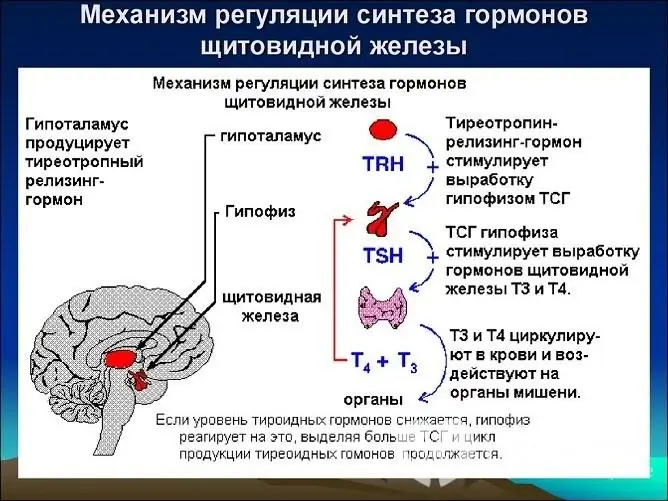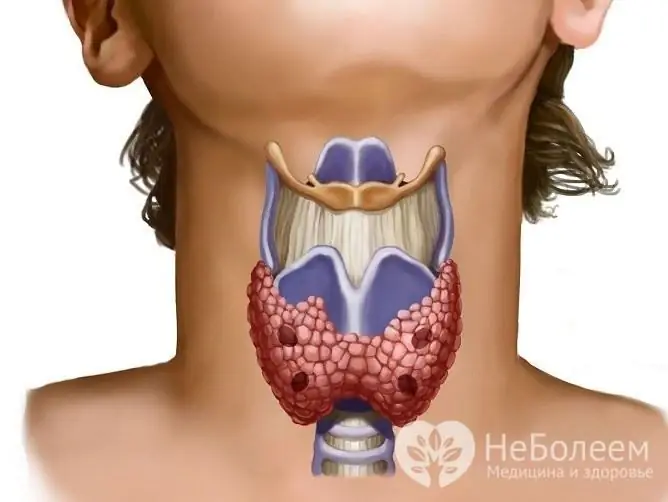- Author Rachel Wainwright [email protected].
- Public 2023-12-15 07:39.
- Last modified 2025-11-02 20:14.
Thyroid hormones and their functions in the body
The content of the article:
- What are thyroid hormones
- Functions of thyroid hormones in the human body
- Signs of deviation from the norm
-
Laboratory determination of the concentration of T 3 and T 4
- Indications for the purpose of the analysis
- Analysis rules
- What to do in case of violation of the production of thyroxine and triiodothyronine
- Video
Thyroid hormones are biologically active substances that are synthesized in the thyroid gland (thyroid gland), are iodized derivatives of tyrosine and are involved in many metabolic processes in the body.

Thyroid hormones are among the main regulators of metabolism
What are thyroid hormones
The thyroid gland produces two thyroid hormones - thyroxine (tetraiodothyronine) and triiodothyronine, which differ in the presence or absence of an additional iodine atom. Thyroxine (T 4) contains 4 iodine atoms, triiodothyronine (T 3) - 3 atoms.
Depending on the chemical structure, all hormones are divided into types:
- steroid;
- derivatives of amino acids;
- derivatives of polyunsaturated fatty acids;
- protein-peptide.
Thyroid hormones are derivatives of the amino acid tyrosine. The synthesis and activation of the main thyroid hormone - thyroxine - occurs with the participation of thyroid-stimulating hormone (TSH), a glycoprotein of the anterior pituitary gland. Thyroxine is formed by the addition of iodine (iodination) to the proteinogenic amino acid L-tyrosine.
The transition of thyroxine to triiodothyronine occurs with the help of selenium-dependent monodeiodinase. In the presence of a congenital defect of monodeiodinase (its decreased activity in tissues), a lack of selenium in the body and / or the use of a number of drugs, a person may experience a deficiency of thyroid hormones against the background of a normal level of thyroxine in the blood.
Functions of thyroid hormones in the human body
The functions of T 3 and T 4 are:
- Metabolism activation.
- Stimulation of processes that ensure the growth and development of the body, differentiation of tissues.
- Stimulation of gluconeogenesis in the liver.
- Increasing the concentration of glucose in the blood and its utilization by the cells of the body.
- Slow down the production of glycogen.
- Inhibition of fat deposition and enhancement of its decay (lipolysis).
- Increased heart rate, blood pressure, body temperature.
- Stimulation of motor and mental activity.
- Increased oxygen demand of body tissues.
- Increased tissue sensitivity to catecholamines.
- Strengthening of erythropoiesis in the bone marrow.
In addition, the properties of T 3 and T 4 include participation in water exchange.
Depending on the level of T 3 and T 4 in the blood, they affect protein metabolism in different ways. So, small concentrations of these substances have an anabolic effect (they can increase the formation of proteins and inhibit their breakdown), and large concentrations have a catabolic effect (inhibition of the production of proteins and an increase in their breakdown).
Signs of deviation from the norm
With insufficient production of these biologically active substances, the patient may experience:
- pallor of the skin (a yellowish tint is possible);
- lethargy and fatigue even with minimal physical exertion;
- increased hair loss;
- impairment of memory and concentration;
- depressive conditions;
- arterial hypertension;
- increase in body weight;
- tachycardia;
- decreased sex drive;
- enlargement of the liver.
If the thyroid gland releases more thyroid hormones, you may experience:
- tremor;
- sharp weight loss;
- disorders of the gastrointestinal tract;
- mental disorders;
- disorders of the heart.
With a decrease in the ability of the thyroid gland to absorb iodine and iodinate tyrosine, the patient may develop a goiter, which squeezes the nearby anatomical structures, makes breathing and swallowing difficult.

Diseases of the thyroid gland affect the synthesis of thyroid hormones
Laboratory determination of the concentration of T 3 and T 4
Most of T 3 and T 4 are in the bloodstream in a bound form. Albumin and thyroxine-binding globulin are capable of binding thyroxine and triiodothyronine. In addition, T 4 is able to bind to transthyretin. Only a small part of thyroxine and triiodothyronine circulates in the blood in free form and is their biologically active fraction.
For this reason, the determination of free triiodothyronine and thyroxine is of particular importance. In addition, the concentration of free T 4 does not depend on the content of thyroxine-binding globulin, which makes it possible to use this diagnostic parameter in physiological and pathological conditions that are accompanied by a change in the concentration of this protein (pregnancy, congenital disorders).
Indications for the purpose of the analysis
- if you suspect a thyroid disease;
- to monitor the effectiveness of the treatment;
- during a preventive medical examination;
- during the gestation of a child (a violation of the production of T 3 and T 4 can lead to abortion, the occurrence of fetal development pathologies);
- children of the first days of life, born to mothers with thyroid pathologies.
The table shows the normal values of the free fraction of thyroxine and triiodothyronine in the blood.
| Index | Reference values |
| Free triiodothyronine (over T 3) | 2.3-4.2 pg / ml |
| Free thyroxine (St. T 4) |
0.89-1.76 ng / dl - for men and non-pregnant women 0.86-1.87 ng / dl - I trimester of pregnancy 0.64-1.92 - II-III trimesters of pregnancy |
Analysis rules
- Blood to determine the level of T 3 and T 4 must be donated in the morning (preferably before 11:00).
- After the last meal, 8-12 hours should pass.
- Before the study, you need to exclude mental and physical overload, the use of fatty foods.
What to do in case of violation of the production of thyroxine and triiodothyronine
If the concentration of T 3 and T 4 in the blood deviates from the norm, the treatment regimen depends on the cause of the pathological process, the patient's symptoms, contraindications.
If the thyroid gland is not producing enough thyroid hormones, the patient is indicated for hormone replacement therapy. With excessive synthesis of these substances, antithyroid drugs are used. In some cases, surgery is required.
Video
We offer for viewing a video on the topic of the article.

Anna Aksenova Medical journalist About the author
Education: 2004-2007 "First Kiev Medical College" specialty "Laboratory Diagnostics".
Found a mistake in the text? Select it and press Ctrl + Enter.






